Contemporary artworks by 12 Leiden artists: Maurice Braspenning – Hans de Bruijn – Casper Faassen – Gijs Donker – Hanneke Francken – Marjolein van Haasteren – Allart Lakke – Johan Scherft – Thomas Raat – Maayke Schuitema – Guido Winkler – Izaak Zwartjes This life-size copy of van Leyden’s 1526 triptych onto canvas (the original is around the corner on display in the Lakenhal until June) by Allan Lakke (www.lakke.com) was wedged behind the stairwell, as if it didn’t quite fit. Here Lakke has ‘copied’ frame and painting as one unit. This reproduction, just like a reproduction a ‘famous painting’ reproduction – flat and photographic – only that this is a life-size copy set under a ceiling that is too low and a stairwell that is in the way, makes it not so much a comment on reproduction as a comment on context. Where does one fit a triptych about the “last judgement” in today’s world? Lakke’s other works in the show, models of tryptychs with blank panels seem in contrast more about the history of reproduction.
This life-size copy of van Leyden’s 1526 triptych onto canvas (the original is around the corner on display in the Lakenhal until June) by Allan Lakke (www.lakke.com) was wedged behind the stairwell, as if it didn’t quite fit. Here Lakke has ‘copied’ frame and painting as one unit. This reproduction, just like a reproduction a ‘famous painting’ reproduction – flat and photographic – only that this is a life-size copy set under a ceiling that is too low and a stairwell that is in the way, makes it not so much a comment on reproduction as a comment on context. Where does one fit a triptych about the “last judgement” in today’s world? Lakke’s other works in the show, models of tryptychs with blank panels seem in contrast more about the history of reproduction.
 Casper Faassen’s triptych, of the same dimensions, omits the figuration evident in Lakke’s. The central panel of frosted glass is illumined by a spot and the hinged two side panels are transparent sheets of glass. Is there nothing to say? Has it all been said? Has the story been removed or is it replaced with a new story? In any case what we are left with in Faassen’s work is an aesthetic of form bordering between high art and the domestic.
Casper Faassen’s triptych, of the same dimensions, omits the figuration evident in Lakke’s. The central panel of frosted glass is illumined by a spot and the hinged two side panels are transparent sheets of glass. Is there nothing to say? Has it all been said? Has the story been removed or is it replaced with a new story? In any case what we are left with in Faassen’s work is an aesthetic of form bordering between high art and the domestic.
Casper Faassens and Allan Lakke are the initiators of this exhibition. They selected the artists, negotiated the location, and found sponsorship.
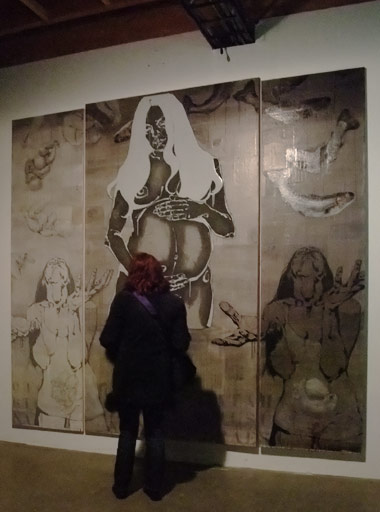 Some artists in the show responded to the themes of life and death, heaven and hell, or judgement such as Maayke Schuitema’s “Magna Mater”. Here a pregnant woman has replaced the crucifix and is flanked by scenes of women who are literally and symbollically juggling symbols of birth and death. Each woman’s womb bears either an symbol for life or death.
Some artists in the show responded to the themes of life and death, heaven and hell, or judgement such as Maayke Schuitema’s “Magna Mater”. Here a pregnant woman has replaced the crucifix and is flanked by scenes of women who are literally and symbollically juggling symbols of birth and death. Each woman’s womb bears either an symbol for life or death. Anyone familiar with contemporarty art can’t help but think of Francis Bacon‘s 1953 iconic screaming pope, and Maurice Braspenning’s painting, “Pope” hold its ground in this context. Braspenning’s pope (the current pope, Benedictus XVI) is more insideous. The scene seems serene. Braspenning’s craftmanship makes the looking enjoyable. However sooner or later you start to see the inconsistences.
Anyone familiar with contemporarty art can’t help but think of Francis Bacon‘s 1953 iconic screaming pope, and Maurice Braspenning’s painting, “Pope” hold its ground in this context. Braspenning’s pope (the current pope, Benedictus XVI) is more insideous. The scene seems serene. Braspenning’s craftmanship makes the looking enjoyable. However sooner or later you start to see the inconsistences.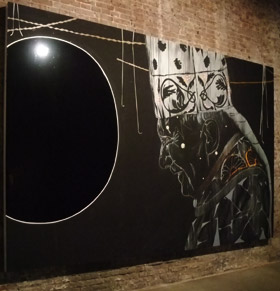
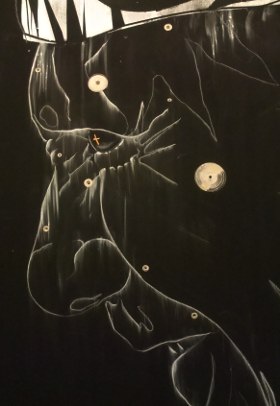 The smile is like too much makeup, and then the faint chalklines, make the decorativeness seem like a facade. And are those white circles puncture holes or signs of decay? Of ruptures in the structure? Is the pope laughing at himself or at an imaginary audience, at God? at the world today? Or is he communicating with a world we are missing? A spirituality we can’t see?
The smile is like too much makeup, and then the faint chalklines, make the decorativeness seem like a facade. And are those white circles puncture holes or signs of decay? Of ruptures in the structure? Is the pope laughing at himself or at an imaginary audience, at God? at the world today? Or is he communicating with a world we are missing? A spirituality we can’t see?
Braspenning’s work is complex and he has kept the vocabulary simple. The title is just “Pope”, the profile is delicate, yet not fussy.
But if you take time, each detail is loaded with messages about the appearances of things. Is the cross in the Pope’s eye a blindspot or a source of guidance? Or is it a cross hair target found in mechanical devices, so that the Pope is a “deus ex machina” – directed from where? from above or from within?
Is the black on the left just a large glossy black oval. A mirror? A void – a symbol for what is missing or a bubble about to burst? Or just a reminder that a surface is just a surface? A reminder of our own materiality.
Braspenning leaves the judgement up to us.
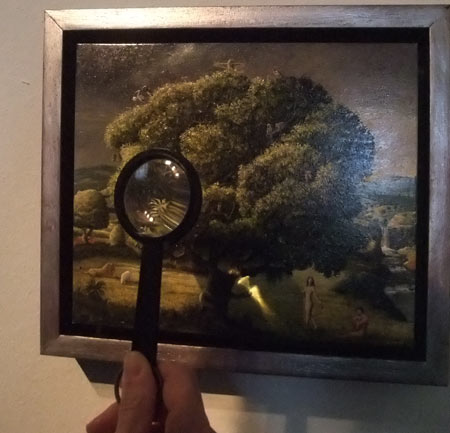 Johan Scherft‘s contribution to the show were a number of finely painted vignettes, which border on outsider art. For the painting, “De Boom van de kennis van goed en kwaad (The tree of good and evil)” a magnifying glass was supplied so you can view the tiny creatures living idyllically in the tree in a Romantic garden before there was any judgement.
Johan Scherft‘s contribution to the show were a number of finely painted vignettes, which border on outsider art. For the painting, “De Boom van de kennis van goed en kwaad (The tree of good and evil)” a magnifying glass was supplied so you can view the tiny creatures living idyllically in the tree in a Romantic garden before there was any judgement.
Marjolein van Haasteren has placed 3 small glossy dark photographs of urban scapes and given these titles such as “Underworld” or “Gate” – the images are from our world, the here and now. Next to these is a large abstracted painting titled “Styx” and above this is a 5th work, a soundscape of subtle rumbling abstract sounds made with Martijn Groen. The diverse media and approach create an almost installation-like experience on themes related to definitions of borders and locations. For example the ‘gate’ could refer to an entrance inside the image presented on the surface of the form underneath the layers of laquer, or to within the depth of the form itself or to the idea of civilisation. Or perhaps the gate is even an escape from the locations presented by the imagery? Likewise with the painting: forms seem to defy gavity and above could be under where the Styx serves as a metaphor for being in a state of transistion. 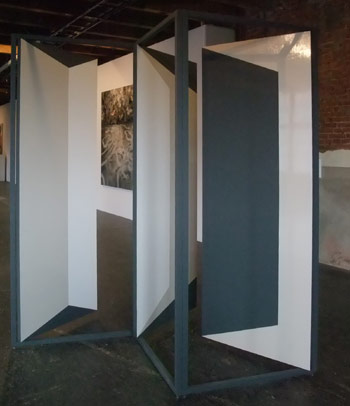
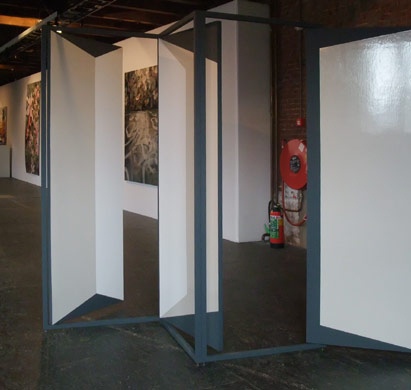
Finally Guido Winkler has made a free standing triptych which you can interact with.
It was fabulous.
All three panels could be moved in a variety of ways.
You could make your own abstact combination or you could see the grey shades as symbollic for shadows or you could make real shadows by positioning the panels.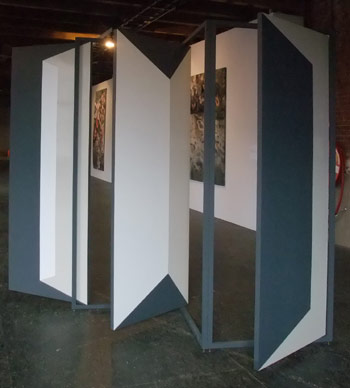
Interacting with this work physically, and moving around the work to view it from various locations, made me think this was a brilliant interpretation on the theme of the show. Judgment was doing -is active and mutable. And in today’s contemporary intellectual world a more ethereal experience. We live in worlds with shades of grey – no longer is this a world where there is a clear right or wrong way of leading one’s life – judgement is in how we lead our lives and our motivation lies in the shades of grey of whatever we call ‘doing good’ than in a medival black and white fear of damnation. How we are judged is in the here and now and in small daily acts, such as whether I moved that panel this way or that way. And finally a judgement of form or aesthetics created by each person is then left for the next visitor to encounter and to change.
‘t Laatste Oordeel -12 actuele interpretaties was on show at the Scheltema Contemporary Arts Centre, Leiden, 26 March – 1 May 2011, www.lovl.nl

Leave a comment